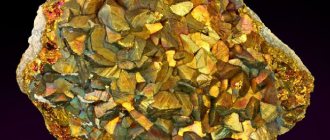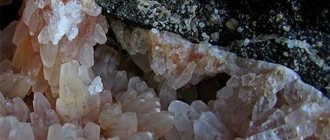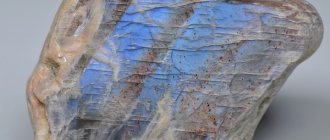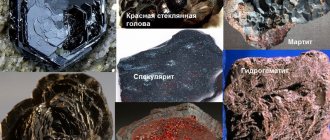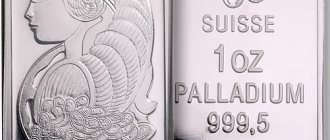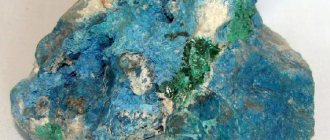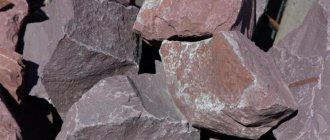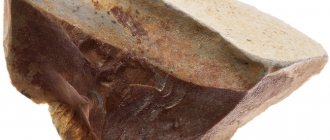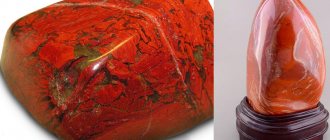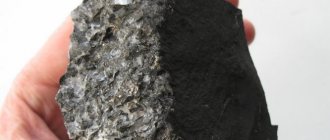Story
Sphalerite has been known since antiquity, but the famous medieval alchemist Gregory Agricola (1546) was the first to study it. He studied, described, but did not name the stone (as was customary in Germany at that time). I just classified it as a “hoax”.
The name was invented three hundred years later by another German scientist, Erich Glocker.
The Greek term σφαλερός means “deceptive.” This is how the main characteristic of the stone was cemented in history - to mimic different minerals.
Researchers took it for galena for a long time, until it turned out that sphalerite does not contain lead.
Sphalerite deposits
Sphalerite is a common mineral. Significant deposits are located in Germany, the Czech Republic and Poland. Magnificent transparent samples suitable for cutting are mined in Spain. Stone mining is also carried out in Australia, Canada, Kazakhstan, South America and Russia.
It is worth highlighting a unique deposit located in the USA, the city of Franklin. Cleiophane is mined there and goes straight to the jewelers.
In addition, in this place, many of the familiar fossils exhibit the ability to fluoresce, which is not observed in other deposits.
What is a stone
The origin of the mineral is twofold: it is formed among sedimentary igneous rocks or hydrothermal vents.
These are grainy translucent, translucent, transparent crystals that shine like diamonds. Or opaque dull ones.
The description of the stone always includes an indication of color. In pure crystals it is white; impurities create brown, brown, and black shades. Colorless, yellowish, purple-orange, and green specimens are considered rare.
The structure of sphalerite is almost the same as that of diamond.
Origin and location
The bulk of the deposits, as well as the galena with which it is almost constantly associated, belong to hydrothermal deposits. In some sulfide deposits it is associated with chalcopyrite.
Widely distributed in metasomatic deposits and ore veins.
It is formed extremely rarely under exogenous conditions. It was found in some coal deposits. During oxidation processes, sphalerite decomposes relatively quickly with the formation of zinc sulfite, which is easily soluble in water, as a result of which the oxidation zones are greatly depleted in zinc. If the side rocks of the deposit are represented by limestones, then accumulations of zinc carbonate - smithsonite - are formed in them. Sphalerite in lead-zinc deposits, as a rule, significantly predominates quantitatively over galena.
Mineral Change
During oxidation processes, the constituent parts of sphalerite are often removed in the form of relatively easily soluble zinc sulfate. Moreover, when located near limestones, sometimes very large accumulations of smithsonite are formed. Under the influence of solutions of sulfate and copper, sphalerite is easily replaced by a blue-black sooty mass of covellite, less often by chalcocite or bornite. As a result of oxidation due to sphalerite, smithsonite, monheimite, calamine, hydrozincite, aurichalcite, soconite, and sometimes limonite and other minerals appear.
Physico-chemical characteristics
For a chemist, sphalerite stone is zinc sulfide. The sphalerite formula includes only two symbols. There are two thirds of zinc in the mineral, the rest is sulfur. This composition is supplemented by impurities.
According to the international classification, the mineral class is defined as sulfide.
| Formula | ZnS |
| Impurity | Fe, Cd, In, Ga |
| Color | Yellow, reddish-orange, greenish-yellow, gray, dark gray, almost colorless |
| Stroke color | Yellowish to light brown |
| Shine | Diamond |
| Transparency | Transparent, translucent |
| Hardness | 3,5—4 |
| Cleavage | Perfect |
| Kink | Uneven; very fragile |
| Density | 4.08—4.10 g/cm³ |
| singonia | Cubic |
| Refractive index | 2,368—2,371 |
It is fragile and cracks in the heat, although it melts with difficulty.
Geographical distribution and scope of application
The stone is widespread and is not scarce on our planet. Mineral deposits are localized in areas of hydrothermal deposits. Countries where sphalerite is found:
- Spain;
- USA;
- Mexico;
- Canada;
- Namibia;
- Germany;
- Poland;
- Russia;
- Australia;
- Czech Republic;
- Kazakhstan.
The characteristics of sphalerite make it possible to use it in the chemical and other industries.
The application is mainly related to the industrial field. Stone is the main material from which zinc metal is extracted, as well as the impurities that make up its composition.
The mineral is widely used in the paint and varnish industry. It is used to produce whitewash, fluorescent paints, signal devices and light compositions.
Zinc sulfide is also obtained from stone without impurities. In this case, the latter will be used as a phosphor. It, in turn, after activation with silver, can be used in the manufacture of picture tubes and TV screens.
Due to its increased fragility, jewelry using the mineral is rarely produced. But if the stone is cut, it is of great interest to collectors and connoisseurs.
Varieties
The following types of sphalerite are distinguished:
- Brunkit. Translucent white or yellowish stone. Object of hunting for collectors.
- Humuchionite. Kidney-shaped translucent crimson or pink stone. The arsenic sulfide in the composition makes it poisonous.
- Cleiophanes. Transparent amber-yellow, greenish-olive crystals. Because of its color, the stone is known as honeyblende.
- Senile. Ferrous, fragile. Looks cracked and out of shape.
- Marmatite. Iron-rich, opaque, matte black formations. The name is given from the place of the first discovery - the Marmato River in Peru.
- He'll be sad. Named after the French scientist Jean Proust. It looks almost like a ruby, which is why it is called ruby blende.
- Příbramit. The difficult-to-pronounce name comes from the name of the city of Příbram (Czech Republic), where the stone was first discovered. These are yellowish translucent crystals saturated with cadmium.
Sometimes classification by color is used.
Sphalerite on quartz
Market cost and principles of care
Sphalerite is often found in nature in crystalline form. Its disadvantage is the difficulty of processing due to poor cleavage. If a cut crystal can be made from it, it is highly valued.
Considering that sphalerite does not reach the status of a semi-precious stone, the price of a product weighing up to 5 carats can reach 300-400 US dollars.
Faceted mineral products are more durable than in their original form. However, they need to be provided with proper care.
Jewelry and crafts made from stones are stored in a separate place. A box lined with velvet on the inside is best suited for this.
Do not expose the product to water, chemicals and keep away from direct sunlight. Do not wear sphalerite every day, be it a ring or an amulet. This way it will retain its original appearance and last for many years.
Areas of use
The main areas of application of sphalerite are serious practical industries:
- Almost all the zinc on the planet is extracted by roasting sphalerite. Along the way, rare earth elements are released: cadmium, indium, gallium.
- Radio electronics, the automotive industry, and the chemical industry cannot do without the mineral.
- The mineral is present in LED screens, signaling equipment, and lasers.
- These are fluorescent paints used by artists, designers, and decorators.
The stone is almost never used by jewelers due to its fragility. Only masters can cut it. The beauty of the stones is comparable to that of precious stones. Such samples are bought up by collectors. Particular importance is attached to transparent yellow, red, and orange crystals from Spain, Bulgaria, and Mexico.
Faceted sphalerite from Spain
How to distinguish natural stones from fakes
Most often, painted glass or plastic is passed off as sphalerite.
You can distinguish a fake by the following signs:
- a real stone is heavier than a fake;
- it is quite fragile, it is easy to scratch or damage;
- The structure of the stone and its color are not uniform - there may be color spots and abrasions.
Jewelers often use artificial sphalerite in jewelry, which can be obtained by passing H2S through a Zn solution in a closed tube and passing the H2S over heated ZnCl2.
The artificial mineral is not a fake; it has a chemical composition similar to natural. What makes it different is that it was created in a laboratory.
Therapeutic effect
Lithotherapists recommend light-colored sphalerite to solve the following problems:
- Skin pathologies (psoriasis, eczema, dermatitis).
- Deterioration of vision, eye diseases.
- Insomnia, apathy, depression, stress, outbursts of aggression, anger.
A dark-colored crystal is suitable as protection against influenza, ARVI, other viral infections, or will help you recover faster.
Compatibility with names and zodiac signs
(“+++” – the stone fits perfectly, “+” – can be worn, “-” – is strictly contraindicated):
| Zodiac sign | Compatibility |
| Aries | + |
| Taurus | +++ |
| Twins | + |
| Cancer | + |
| a lion | + |
| Virgo | + |
| Scales | + |
| Scorpion | — |
| Sagittarius | + |
| Capricorn | + |
| Aquarius | + |
| Fish | + |
The exact influence of sphalerite on individual signs of the Zodiac has not yet been established by experts. Reliable information about the influence of the stone on some representatives of the zodiac circle is given only in relation to Taurus and Scorpio:
- The mineral favors Taurus. This sign can wear a stone as a talisman or talisman, or keep it in the house. It will help attract good luck, improve health, and achieve financial well-being.
- Scorpios should avoid sphalerite, since regular contact with this stone will make them irritable and conflict-ridden.
Names that suit sphalerite:
- Alexander (Alexandra);
- Arthur;
- Victor;
- Maksim;
- Paul;
- Faith;
- Victoria;
- Galina;
- Daria;
- Catherine;
- Natalia;
- Tatiana;
- Pauline.
Is this stone right for you?
Magic properties
The magical influence of a stone is determined by its color. For example, white or yellow samples are used as universal amulets:
- They are able to protect a person by creating an impenetrable “cocoon” from damage, the evil eye, and energy attacks.
- A rough stone is placed at the entrance to a home as a guard against uninvited guests. His magic will create an atmosphere of peace and harmony in the house.
Black stones are an attribute of the rituals of black magicians, a channel of communication with the other world. However, a not particularly advanced “user” is guaranteed to receive the negative message sent back.
Sphalerite: healing properties of the stone
In alternative medicine, the mineral sphalerite is used to increase immunity and overall vitality of the body. There is information that preparations made from this stone are effective in cleansing the blood and treating disorders of the digestive system (due to the presence of a large amount of zinc in them).
Since ancient times, healers have used sphalerite to treat hypothermia, as well as to restore vision. Stone amulets help those people who suffer from insomnia or nervous disorders.
How to care for jewelry
Natural sphalerite is a very fragile stone in its structure. It is almost never used to create jewelry. But if such value still exists among family jewelry, then it must be looked after with the utmost care. The slightest blow can cause scratches and chips on the stone that cannot be restored. The samples are kept in boxes that are tightly buried and have soft inserts inside.
The mineral can be cleaned, but this must be done in cool running water without soap. After washing, the products are wiped well and dried thoroughly.
Following simple storage rules will allow you to preserve the gem and enjoy its beauty for many years.
Collectible sphalerite and astrophysics
To register elementary particles arriving from deep space, it is not necessary to build giant colliders. Such scientific experiments can be carried out using a large single crystal of sphalerite activated with rare earth metals or silver. From a physics point of view, such a crystal is a natural scintillator - an almost magical device capable of emitting visible light (photons) when hit by invisible alpha particles, electrons, gamma rays and other ionizing radiation. In this case, the number of photons approximately corresponds to the number of elementary particles captured by the sphalerite scintillator crystal.
All that remains is to equip the modified crystal with a photodetector, and then instruct the computer to register and count flashes of light converted into current pulses.
The magic of the Black Nest
The black crystal of sphalerite is capable of deceiving not only simple-minded miners, it dangerously misleads even experienced magicians.
In magical practices, black crystals are used for mental penetration into the afterlife, casting spells on people and pets. Such accessories include morion, obsidian, jet, black tourmaline, opal, carbonado diamond, black amber (stanthienite), etc. But if a sorcerer performs a spell ritual with a crystal of black zinc blende (the modern name is marmatite), then the curse can turn against itself. caster. The sorcerer is not able to remove it on his own; this can only be done by another magician. In this case, the unlucky spellcaster falls into slavery to the wizard who rescued him.
In magical treatises, the Druze call such treacherous sphalerite-marmatite crystals the “Black Nest.”
Sphalerite jewelry
No matter how beautiful sphalerite is, jewelers treat it with caution. The stone is very fragile; when cutting, a beautiful crystal often crumbles, nullifying all the painstaking work. A common form of sphalerite processing is cabochon (hemisphere, ellipse) and flat inserts.
Why is sphalerite, with its shine similar to a diamond, so cheap?
Firstly, this mineral is not rare, like semi-precious stones.
Secondly, it is relatively soft, fragile, and therefore short-lived. Polished crystals in jewelry can easily be scratched or accidentally chipped, and over time they lose their luster.
Application of the mineral
This ore sample serves as one of the main sources of raw materials for the production of zinc.
Also, in addition to zinc, expensive rare precious metals are extracted from ore, which are used in instrument making using modern technologies. Zinc is more widely used in production, for example in the manufacture of paints and varnishes (zinc white). The produced zinc is applicable in the pharmacological field as it has antiseptic properties.
The color is often brown (almost black), brown
Sphalerite is used to prepare paints that have luminous properties; the mineral is also suitable for creating electro-beam devices that convert electrical signals into light.
Pure sphalerite stone is not used in souvenir and ornamental crafts, but in tandem with quartz and galena it is very successfully processed to create souvenirs. As noted above, the stone is fragile and is rarely used by jewelers. But still, rare jewelry is created in the form of pendants, rings, men’s rings, etc. Of course, unique specimens of sphalerite end up in collections.
Powerful amulets
But white crystals of sphalerite and its yellow-honey varieties (cleiophane, brunkite, prshibramite) are used to make powerful amulets. These stones are able to protect not only the owner, but also all his loved ones living under the same roof, including pets, from the influence of negative energy.
Such protective amulets are druses of large sphalerite crystals of any color (with the exception of black). In addition to the esoteric functions of a home amulet, collectible stones will certainly serve as a stylish decoration for the interior of your apartment.
Curious facts
Sphalerite has always been considered a helper for people who lack self-confidence.
It helps them strengthen their fortitude and leadership qualities. The effect will be noticeable even if you simply put sphalerite on the photo of its owner. Talismans are made from raw samples of any color except black. Depending on the iron concentration, sphalerite reacts differently to high temperatures. If there is a large admixture of iron, the mineral will melt, but pure sphalerite will remain unchanged.
Interesting things about the stone
Despite its little popularity in wide circles, sphalerite still remains a rather interesting mineral:
- Talismans and amulets with this stone are recommended for wearing by people who lack self-confidence. Surprisingly, this small crystal can awaken real leaders in some people who can achieve whatever they want in a short time. But for amulets you need to choose untreated stones of any color (just not black). Also, since ancient times, this mineral was used as a kind of “dream catcher”, i.e. relieved nightmares, insomnia and sent pleasant, peaceful dreams to the wearer.
- How high temperatures will affect the stone depends on how much iron is included in the selected sample. If there is enough iron, then the stone will melt, and if the mineral is pure, then it cannot be penetrated by any blowpipe. The purity of the stone is also indicated by the color of the sediment in the reduction flame: if there is a lot of cadmium in the sample, you will notice a red-brown coating; in clean samples, the coating is white.
